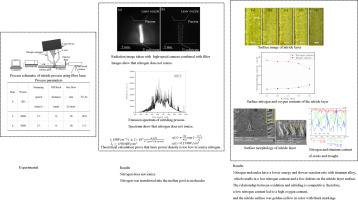Surface & Coatings Technology ( IF 5.3 ) Pub Date : 2021-05-01 , DOI: 10.1016/j.surfcoat.2021.127254 Jinchang Guo , Yu Shi , Chunkai Li , Gang Zhang

|
A nitride layer can be formed on the surface of a titanium alloy during laser gas nitriding, to improve the surface hardness and wear resistance of the titanium alloy. Importantly, the nitride layer is influenced by the nitrogen ionization state (nitrogen molecules or nitrogen atoms and ions). No research reports exist on the nitrogen ionization state or the effect on the nitride layer during fiber laser nitriding of titanium alloys. Radiation images that were taken with a high-speed camera and emission spectra that were collected with a fiber spectrometer were used to study the nitrogen ionization state. To study the effect of nitrogen ionization state on the nitride layer, the surface nitrogen and oxygen content were measured with an electro-probe microanalyzer, and the surface morphology of the nitride layer was studied by optical and scanning electron microscopy. The experimental results showed that the laser power density was too low to induce nitrogen ionization during fiber laser gas nitriding of the Ti-6Al-4V alloy. The nitrogen molecules had a lower energy than the nitrogen plasma (nitrogen atoms and ions) and a slower reaction rate with the titanium alloy, which resulted in a low nitrogen content and a few defects in the nitride layer. The relationship between the oxidation and nitriding was competitive; that is, nitrogen and oxygen competed to react with the titanium alloy. As such, a low nitrogen content led to a high oxygen content, and the nitride surface was golden-yellow in color with black markings.
中文翻译:

Ti-6Al-4V合金激光气体氮化过程中氮离子态及其对氮化层影响的研究。
可以在激光气体氮化期间在钛合金的表面上形成氮化物层,以提高钛合金的表面硬度和耐磨性。重要的是,氮化物层受氮离子化状态(氮分子或氮原子和离子)的影响。尚无关于钛合金纤维激光氮化过程中氮离子化态或对氮化物层影响的研究报道。使用高速相机拍摄的辐射图像和纤维光谱仪收集的发射光谱来研究氮离子化状态。为了研究氮离子化状态对氮化物层的影响,用电探针显微分析仪测量了表面氮和氧的含量,并通过光学和扫描电子显微镜研究了氮化物层的表面形态。实验结果表明,在Ti-6Al-4V合金的光纤激光气体氮化过程中,激光功率密度过低,无法引起氮离子化。氮分子的能量低于氮等离子体(氮原子和离子)的能量,并且与钛合金的反应速度较慢,这导致氮含量低且氮化物层中的缺陷少。氧化和氮化之间的关系是竞争性的。也就是说,氮和氧竞争与钛合金反应。这样,低的氮含量导致高的氧含量,并且氮化物表面的颜色为金黄色,带有黑色标记。实验结果表明,在Ti-6Al-4V合金的光纤激光气体氮化过程中,激光功率密度过低,无法引起氮离子化。氮分子的能量低于氮等离子体(氮原子和离子)的能量,并且与钛合金的反应速度较慢,这导致氮含量低且氮化物层中的缺陷少。氧化和氮化之间的关系是竞争性的。也就是说,氮和氧竞争与钛合金反应。这样,低的氮含量导致高的氧含量,并且氮化物表面的颜色为金黄色,带有黑色标记。实验结果表明,在Ti-6Al-4V合金的光纤激光气体氮化过程中,激光功率密度过低,无法引起氮离子化。氮分子的能量低于氮等离子体(氮原子和离子)的能量,并且与钛合金的反应速度较慢,这导致氮含量低且氮化物层中的缺陷少。氧化和氮化之间的关系是竞争性的。也就是说,氮和氧竞争与钛合金反应。这样,低的氮含量导致高的氧含量,并且氮化物表面的颜色为金黄色,带有黑色标记。氮分子的能量低于氮等离子体(氮原子和离子)的能量,并且与钛合金的反应速度较慢,这导致氮含量低且氮化物层中的缺陷少。氧化和氮化之间的关系是竞争性的。也就是说,氮和氧竞争与钛合金反应。这样,低的氮含量导致高的氧含量,并且氮化物表面的颜色为金黄色,带有黑色标记。氮分子的能量低于氮等离子体(氮原子和离子)的能量,并且与钛合金的反应速度较慢,这导致氮含量低且氮化物层中的缺陷少。氧化和氮化之间的关系是竞争性的。也就是说,氮和氧竞争与钛合金反应。这样,低的氮含量导致高的氧含量,并且氮化物表面的颜色为金黄色,带有黑色标记。











































 京公网安备 11010802027423号
京公网安备 11010802027423号